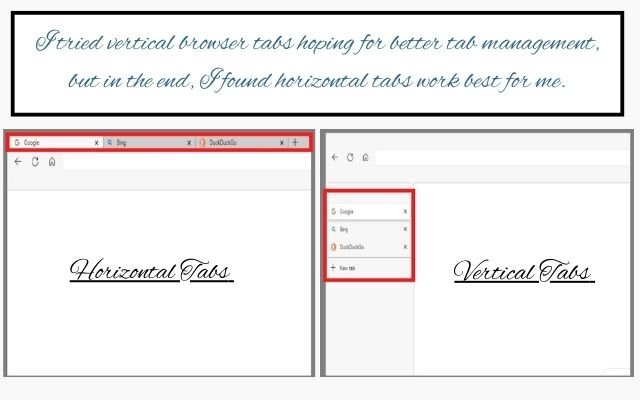Tried Vertical Browser Tabs — Here’s What Sent Me Back to Horizontal
Tried vertical browser tabs in Edge, Firefox, and more. Here's why I switched back to horizontal tabs for better ease and comfort.

Vertical browser tabs have become a popular feature in many web browsers. Many people say they make it easier to manage lots of open tabs. Some browsers now have this feature built-in, while others offer it through extensions.
I was curious to see how vertical tabs work. The idea of getting more space at the top of my screen sounded good. I thought it might help me stay more organized while browsing.
So, I decided to give vertical tabs a try in different browsers. I tested them in Microsoft Edge, Firefox, Vivaldi and a few others. I used vertical tabs for some time to see if they really made a difference.
But after spending some time with this new layout, I realized it just wasn’t for me. It didn’t feel as comfortable or convenient as I expected. In the end, I found myself going back to horizontal tabs because they still work best for me.
The Problem with Using Vertical Tabs on Multiple Monitors
I use four monitors for work, so I need a browser that handles multiple screens well. Browsers like Chrome and Edge make this easy — you can just drag a tab to another screen, and it opens as a new window without any issues.
But vertical tabs don’t work as smoothly in this setup. Even though browsers like Arc and Zen have the best vertical tab designs, managing multiple windows across different monitors becomes a hassle.
If your monitors are placed side by side, vertical tabs can break the smooth flow between two web pages you’re switching between. Hiding the vertical tab bar might fix this, but then it’s easy to lose track of your tabs. That defeats the purpose of using multiple monitors, which is to easily manage several windows at once.
Vertical Browser Tabs Make Tab Organization a Challenge
Organizing tabs with a vertical layout can be tricky. With horizontal tabs, it’s easy to group them and collapse the groups for better tab management. This helps keep things clean and organized.
With vertical tabs, you can see more tab names, but most browsers don’t offer a simple way to group them. So, you just end up with a long list of tabs to scroll through, which can feel messy.
Of course, how you organize your tabs depends on personal preference. But since most of us are used to horizontal tabs, it naturally feels easier to manage and organize them that way.
Browsers like Arc and Zen do offer options like pinning tabs to the sidebar. However, this takes up a lot of space, leaving less room for your regular tabs. As a result, you often have to scroll just to find the tab you need, which makes tab management harder.
Vertical Tabs Reduce Your Browsing Space
Vertical tabs can waste a lot of screen space, especially if you’re using a 14-inch or 13-inch laptop. It becomes even more noticeable when you’re working in split-screen mode because the vertical tab bar itself can take up a big part of one window. Unless you’re okay with collapsing the tab bar, you’ll end up losing valuable space on your screen.
Of course, this depends on personal preference. Some people might actually like the extra height vertical tabs give, especially for reading. But if you’re like me and often work with three or more tabs side by side in a split-screen view, screen space becomes a problem pretty fast.
Vertical Tabs May Not Work Smoothly on All Websites
Even though many websites don’t fully use the width of your screen, they don’t always work well with vertical tabs. Depending on how the browser handles page elements and the vertical tab bar, you might notice weird glitches or overlapping parts of the page.
While it’s rare for a website to completely break, constantly collapsing and expanding the vertical tab bar can sometimes mess up the layout. This is especially true on websites like X (Twitter) or Instagram, where a lot of buttons and menus are placed around the edges of the screen.
You might accidentally click the wrong button or miss a link because of these issues. A quick refresh usually fixes it, but it still gets annoying. If a website doesn’t work well, you might have no choice but to switch back to horizontal tabs or even use a different browser.
- How Reflection App Became My Daily Guide to Self-Improvement
- 4 Tasks Where DeepSeek works better than ChatGPT (And Why I Use It Instead)
- How to Make Your Photos Look Old and Add Retro Vibes Easily
Horizontal Tabs Work Better for Me
In my search for the perfect Windows browser, I’ve tried many options, including Arc, OperaGX, and Zen. While vertical tabs have their advantages, I still find horizontal tabs much more convenient. It’s easier to move tabs around, group them, and they don’t cause any issues with websites.
Of course, this is just my personal preference. Some people might find vertical tabs easier to use. But with all the UI elements I interact with in a browser window, horizontal tabs feel simpler and more comfortable. Plus, since they’re always visible at the top, it’s hard to lose track of a tab — unless you have way too many open.
That said, vertical tabs could still work if they’re designed well. Right now, the way Arc and Zen handle them isn’t great, especially if you use multiple monitors on Windows. No matter the benefits, I’ll be sticking with horizontal tabs for now because they just work better for me.
FAQ
1. Are vertical browser tabs better than horizontal tabs?
Vertical tabs can help manage lots of open tabs by showing more tab names, but they may take up more screen space and feel harder to organize. Horizontal tabs are more familiar and easier to manage for most users.
2. Which browsers support vertical tabs?
Browsers like Microsoft Edge, Vivaldi, Arc, and Brave support vertical tabs either natively or through extensions. Firefox and Chrome may need extensions for vertical tab support.
3. Do vertical tabs save screen space?
Vertical tabs give you more space at the top of your screen but use up space on the side. On smaller screens or in split-screen mode, they can reduce your browsing space.
4. Are vertical tabs good for multi-monitor setups?
Vertical tabs are not ideal for multi-monitor setups. Moving tabs between screens or windows can be tricky, making horizontal tabs a better choice for smooth multitasking.
5. Can vertical tabs cause website display issues?
Some websites may not display properly when using vertical tabs, causing overlapping buttons or menus. This is common on sites like X (Twitter) or Instagram.



